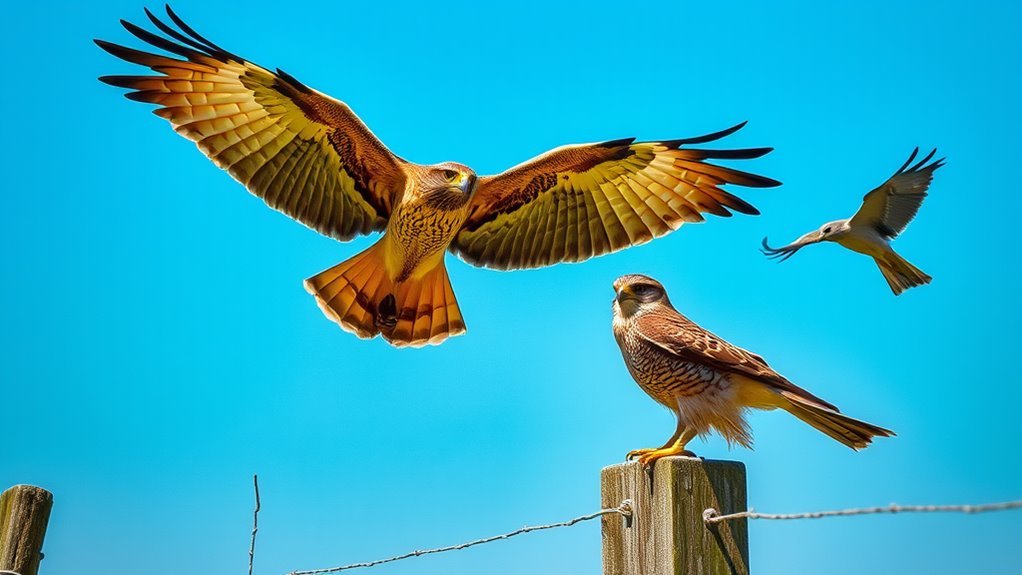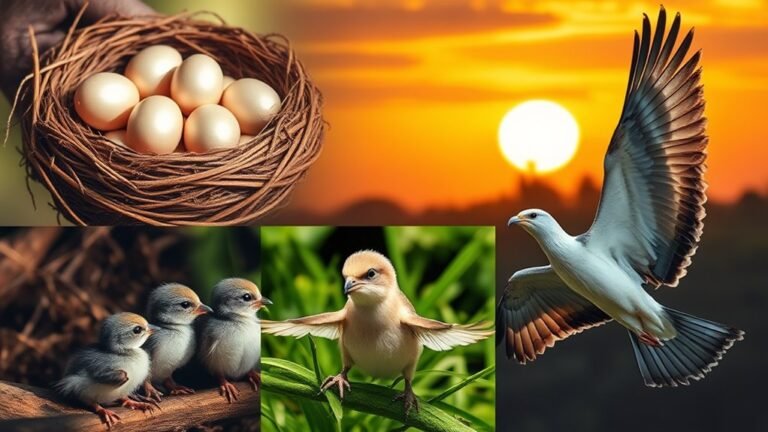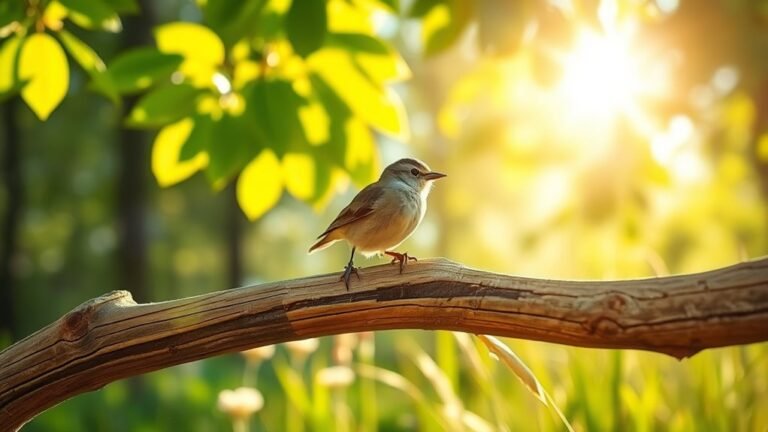A Guide to British Birds of Prey
When you look up at the skies of the UK, you can find a variety of birds of prey. These birds are important for their ecosystems. Each type, like the strong Golden Eagle and the quick Kestrel, has its own way of hunting. Learning about their actions shows how vital they are in nature. It also prompts thoughts about their protection. What can these birds tell us about the health of our environment?
Key Takeaways
- British birds of prey, or raptors, inhabit diverse ecosystems, playing vital roles in maintaining ecological balance.
- Notable species include the Golden Eagle, Peregrine Falcon, and Red Kite, each exhibiting unique hunting techniques and adaptations.
- Raptors like the Hen Harrier and Kestrel showcase various hunting styles, from gliding to hovering for efficient prey capture.
- Conservation efforts have successfully rebounded populations of birds like the Red Kite, highlighting the importance of habitat protection.
- Observing raptors in their natural environment fosters appreciation for their beauty and connection to biodiversity.
Overview of British Birds of Prey
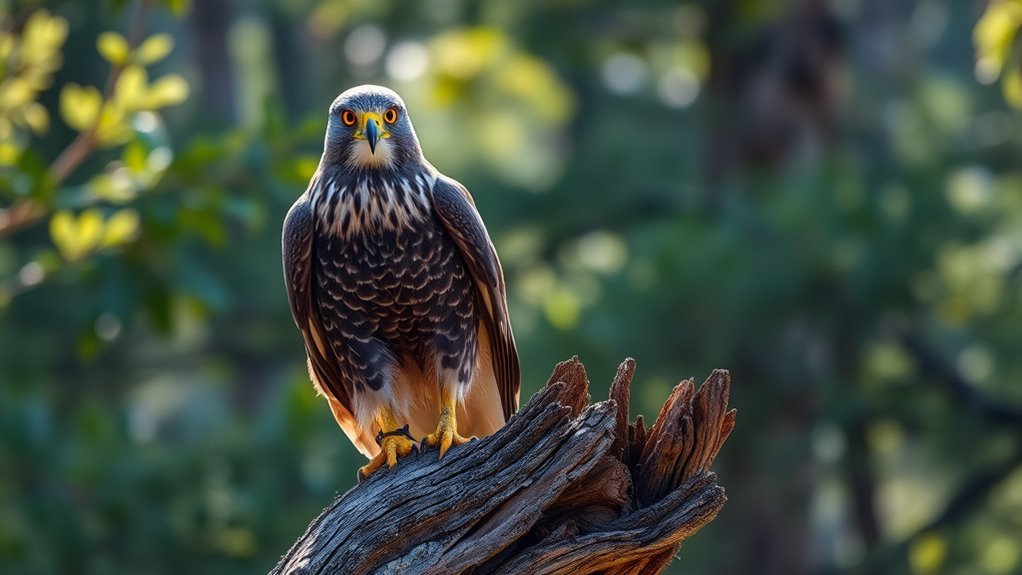
British birds of prey, also known as raptors, are fascinating and powerful animals. They live in various habitats across the UK, such as woodlands, moors, and coastal cliffs. These environments provide them with ample hunting opportunities.
Raptors use different hunting techniques. Some birds surprise their prey by swooping down quickly. Others fly high above the ground to spot movement before they dive down.
Learning about where these birds live and how they hunt can deepen your appreciation for them and help you connect with nature.
Golden Eagle: The Majestic Hunter
The golden eagle is one of the most impressive birds of prey in the UK. This strong and graceful hunter lives in the rugged mountains and remote glens of Scotland.
With a large wingspan and sharp eyesight, golden eagles can spot their prey from far away. They primarily hunt small mammals like rabbits and young deer, showing their skills as adaptable predators.
Watching a golden eagle fly showcases nature's beauty and helps you feel more connected to the wild. Their presence highlights the importance of maintaining balanced ecosystems and the joy of seeing such a magnificent bird in its natural habitat.
Peregrine Falcon: Speed and Agility
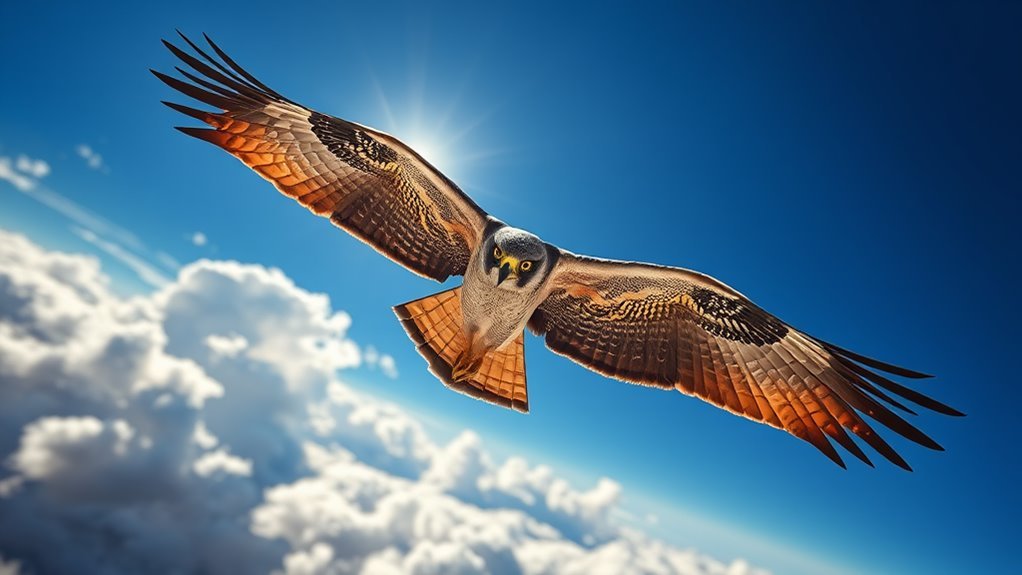
Have you ever watched a peregrine falcon hunt? These birds are famous for their incredible speed and agility. They can dive at speeds over 240 miles per hour to catch their prey. Their hunting style is impressive; they often grab birds mid-air during a fast stoop. Their sharp eyesight helps them spot targets from far away.
During the breeding season, peregrine falcons form strong pairs and care for their young. They usually build nests on high ledges, which keeps their chicks safe from predators.
Observing these behaviors helps us appreciate their lives and connect with nature.
Common Buzzard: The Versatile Predator
The common buzzard is a skilled predator that can often be seen flying in the sky. It thrives in various habitats, such as woodlands and open fields. You may notice it perched on trees or fences, watching the ground for potential prey.
The buzzard hunts by gliding low and using its sharp eyesight to spot small mammals and carrion. Its ability to adapt its diet based on what's available highlights its resourcefulness.
Whether it's ambushing animals or scavenging, the common buzzard showcases its ability to survive. This bird is an important part of the British landscape and represents the idea of adaptability in nature.
Red Kite: A Conservation Success Story

The red kite is a striking bird of prey known for its forked tail and bright colors.
It has made a strong comeback in Britain after nearing extinction due to hunting and loss of habitat. Conservation efforts have successfully increased its numbers.
These efforts included making laws to protect the red kite, restoring its habitats, and raising public awareness.
Now, many red kites fly freely across Wales and other regions, representing successful wildlife management.
Seeing a red kite in flight is a reminder of what communities can achieve together. Supporting ongoing conservation helps ensure this beautiful species continues to thrive and restore Britain's natural heritage.
Hen Harrier: The Marshland Specialist
Hen harriers are skilled birds of prey found in Britain's marshlands. They glide gracefully over fields and wetlands, which are their main habitats.
These birds hunt mainly at dawn and dusk, using their sharp eyesight to spot small mammals and birds from above.
Male hen harriers have striking gray-and-black feathers, while females have mottled brown plumage.
Hen harriers play an important role in the ecosystem by helping control prey populations. They also captivate birdwatchers who appreciate their beauty in nature.
Kestrel: The Small but Mighty
Kestrels are small but powerful birds of prey. They're known for their ability to hover in place while searching for food. You can often see them flying in open fields and urban areas across Britain. Kestrels glide on thermals, using their keen eyesight to spot small rodents below.
One unique characteristic of kestrels is their "hover" behavior. In this position, they stay suspended in the air, allowing them to hunt effectively despite their small size.
Kestrels thrive in many habitats, including grasslands and cities, showing their adaptability. These birds prefer open spaces where they can easily find prey.
Their presence in the ecosystem is important. They help control pest populations, which benefits the environment. Watching kestrels in action connects wildlife enthusiasts with nature and highlights the importance of these remarkable birds.
Sparrowhawk: The Urban Falcon
The sparrowhawk is a bird of prey that thrives in urban environments. It's known for its speed and agility, which it uses to hunt small birds in city areas.
This raptor hunts by quickly dashing through vegetation, surprising its targets. Unlike larger hawks, sparrowhawks operate in thick foliage where smaller birds hide. Urban spaces offer plenty of food, helping these birds to flourish.
When you watch a sparrowhawk hunt, you can appreciate its precise techniques. This bird plays an important role in the ecosystem, balancing nature with urban life.
Osprey: The Expert Fisher
Ospreys fly above rivers and lakes, using their sharp eyes to spot fish. They dive quickly, stretching their feet and ready to catch their meal. Their special ability to see polarized light helps them find fish underwater.
In nesting season, ospreys build their nests on high structures like platforms or trees near water. This choice allows easy access to food and keeps their young safe.
Watching ospreys hunt and care for their young highlights the connection between how they survive and where they live. Their skills shine in both finding food and nurturing their families, making them fascinating birds to observe.
The Role of Birds of Prey in Ecosystems
Birds of prey are important for ecosystems. They help control herbivore populations. This prevents overgrazing and supports diverse plant life.
By managing these populations, they promote healthier ecosystems where many species can live together.
These birds also hunt pests that can harm ecosystems. When we watch birds of prey, we can see how they affect many different species and their interactions.
Protecting these birds helps maintain the overall balance in nature. By safeguarding them, we help preserve the intricate relationships in the web of life that sustains all living things.
Frequently Asked Questions
What Is the Best Time to Spot Birds of Prey in the UK?
The best time to spot birds of prey in the UK is during autumn migration. These birds can be found in moors and wetlands. They look for food and rest before they continue their journey. Observing them in these areas can be a rewarding experience for birdwatchers.
How Can I Attract Birds of Prey to My Garden?
To attract birds of prey to your garden, create a natural habitat. Add bird feeders filled with small birds to provide food. Increase the amount of vegetation to give them cover. Also, include high perching spots for them to observe their surroundings. These steps will help draw these impressive birds while benefiting your garden's ecosystem.
Are There Any Laws Protecting British Birds of Prey?
Yes, British birds of prey are protected by law. Several conservation laws exist to protect these birds and their habitats. These laws help maintain their populations, allowing everyone to enjoy these incredible creatures in nature.
What Do I Do if I Find an Injured Bird of Prey?
If you find an injured bird of prey, contact a local wildlife rescue right away. Place the bird in a quiet and dark area to reduce its stress. Avoid feeding or treating the bird yourself, as trained professionals are better prepared to help. Your quick action can make a difference in the bird's recovery.
How Can I Get Involved in Bird of Prey Conservation?
You can help with bird of prey conservation by volunteering with local conservation groups. You can participate in habitat restoration projects, educational programs, or bird monitoring activities. These opportunities allow you to connect with others who share your passion while making a positive impact on these impressive birds. Join a community effort to ensure their protection and survival. Get involved today!

Hello, I’m Emily Price, the founder of Birds Affection. As a passionate bird enthusiast and spiritual seeker, I’ve always been fascinated by the symbolic meanings and mystical connections between birds and our lives. On this website, I share my knowledge and insights on the spiritual significance of various bird species, exploring their roles as messengers, guides, and teachers. Through my writing, I aim to inspire and educate others on the profound wisdom and beauty that birds bring to our world. Join me on this journey as we delve into the enchanting realm of bird symbolism and discover the hidden meanings behind these magnificent creatures.

